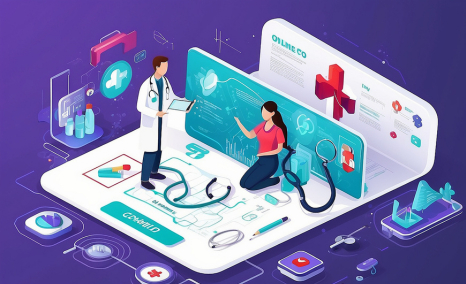Table of Contents
Over the past two years, the coronavirus disease 2019 (COVID-19) pandemic has significantly impacted the global healthcare industry. The pandemic has resulted in a substantial spike in demand for at-home services. Similarly, three has been a great jump in the telemedicine industry. In particular, the need for Telepsychiatry has also grown significantly. Telepsychiatry is a subset of telemedicine, and it provides a platform bridging the gap through advanced technologies connecting mental health providers and patients who need mental healthcare services. It holds immense potential to overcome challenges such as distances, lack of transportation, and even time constraints. Like in the case of Telemedicine, Telepsychiatry is a great tool for the people residing in underserved and remote areas to fulfill and access mental healthcare services where in-person care is not possible.
What is Telepsychiatry?
Telepsychiatry is a subset of Telemedicine, which is related to the remote assessment, diagnosis, and treatment of patients through the use of real-time interactive telecommunication audiovisual technology. Telemedicine encompasses consultations over the phone, video calls, or text messaging, in addition to the digital transmission of medical imaging and remote diagnosis. Similarly, Telepsychiatry is a specific application of telemedicine that deals with delivering a broad range of psychiatric services such as mental health diagnoses, medication management, and administering treatment or therapy (which includes individual therapy, family therapy, and group therapy) via technological communication. It also includes services like patient education, psychiatric assessment, and counselling. The term Telepsychiatry’s initial use dates back to the 1950s; however, real progress has only been observed in recent years. Telepsychiatry can also be provided through a recorded session in the form of images or audio-video files for later reviewing. Telepsychiatry works similarly to traditional in-person appointments, and through it, the psychiatrist or the doctor can create and implement treatment plans, prescribe medication, schedule follow-up appointments, and refer the client to a more specialized center for further treatment.
Telepsychiatric may be carried out synchronously and asynchronously. In the synchronous method, live or real-time treatment and counseling are provided through the telephone, video calls, and web-conferencing platforms. While in asynchronous Telepsychiatry, there is delayed communication between clients and providers. As of now, several mobile application interventions are being developed, which are available and can be used for real-time monitoring and assessing patients and providing treatment. Telepsychiatry is an effective option for people suffering from different mental health disorders such as anxiety, eating disorders, substance abuse, schizophrenia, and several others. As the Telepsychiatry segment is observing significant growth, it holds the potential to become a great alternative to traditional in-person psychiatric services.
Why is the Demand for Telepsychiatry Services Growing?
Substance use disorders (SUDs), serious mental illness (SMI), and serious emotional disturbances (SEDs) impact a significant proportion of the population worldwide. A barrier to accessing appropriate treatment & care and stigma associated with these disorders affects the employment and caregiving responsibilities multiple times. Telepsychiatry is an interactive avenue to get the required treatment and make treatment services more accessible and convenient.
People across different age groups are availing Telepsychiatry services to deal with mental health conditions and get better treatment outcomes for disorders such as anxiety, schizophrenia, depression, and many others. Telepsychiatry can also be a way to provide specialized care in the case of autism or obsessive-compulsive disorder.
Globally, the prevalence of mental health disorders such as anxiety and stress is on rise. Especially among young adults, major growth has been observed in tendencies of suicide. As per the WHO, “depression is one of the leading causes of disability worldwide. Suicide is the fourth leading cause of death among 15-29-year-olds. People with severe mental health conditions die prematurely – as much as two decades early – due to preventable physical conditions.” As per Mental Health America, Inc., “in 2019, just before the COVID-19 pandemic, 19.86% of adults experienced a mental illness which is nearly equivalent to 50 million Americans.” Additionally, an estimated 2.5 million youth in the United States have severe depression, and about 10.6% of youth have severe major depression (depression that severely affects functioning) in the US”
The demand for mental health care is also growing, and Telepsychiatry offers an innovative perspective and effective solution to all the rising mental health problems. Telepsychiatry makes it easier for patients to continue their treatment and follow-up plans without delays, dramatically reducing transportation barriers and cost issues. Despite several awareness programs and initiatives by health bodies and governments, people with mental health conditions often experience discrimination and stigma. Telepsychiatry can be a major route to overcoming the stigma and misconceptions associated with mental health treatment. Additionally, it provides an excellent opportunity for psychiatric interventions and assessments and access to various experts sitting at different locations. The accessibility of medical healthcare facilities is one of the key challenges in rural and remote areas. Telemedicine and Telepsychiatry can bring a significant change to mental health disorders in remote areas that too with a relatively low cost.
What are the Key Benefits of Telepsychiatry?
The adoption of Telepsychiatry can help the user easily access mental healthcare services while being at home, which is a major benefit. Additionally, overcoming barriers of great distances, lack of transportation, lower attrition rates, and reduced waiting time are other major benefits of Telepsychiatry. People of all ages, including children, adolescents, and adults, can benefit from Telepsychiatry.
Moreover, follow-up and medical management are other challenges in in-person visits, which Telepsychiatry can reduce to a much larger extent. As per estimates, nearly 3.6 million Americans cannot receive medical care due to a lack of transportation. Similarly, as per the study conducted, it is observed that there is not much difference observed between telepsychiatry and in-person visits. In fact, improved response rates, feasibility, satisfaction, and acceptability were observed with the use of telepsychiatry.
People with autistic behavior and those suffering from severe anxiety disorders are more comfortable with telepsychiatry than face-to-face treatment. Similarly, it is an excellent tool for caregivers and can provide much greater relief. Telepsychiatry increases patient satisfaction, and the benefit of Telepsychiatry is not just limited to the patients. The physicians and the hospitals/clinics also benefit immensely from adopting Telepsychiatry in their system. It allows the clinicians greater flexibility in patient scheduling and reduces overhead practice costs. It can reduce physician burnout and burden. Additionally, it reduces the strain on their co-workers and requires fewer healthcare professionals.
What are the Major Challenges Associated with the Use of Telepsychiatry?
Telepsychiatry is a beneficial and promising service, but it has several challenges and issues associated with it. It is not a cure for all mental health issues. Setting up the required infrastructure is not that easy; it requires heavy investment and time. Similarly, it also takes time for the general public to adopt the change and embrace the change in medical delivery methods.
Technological literacy of both physician and patient is also one of the key requirements for delivering the services. Similarly, eliminating the in-person patient-doctor interaction is not possible in some cases. Like many patients, especially in old age, people may prefer in-person visits. It affects the direct communication and consultation between patients and psychiatrists. It becomes essential to address and modify or change the Telepsychiatry service delivery with time to maintain the user’s confidence and trust.
Key Companies in the Telepsychiatry Market
Some of the key companies in the Global Telepsychiatry Market include SOC Telemed, JSA Health Psychiatry, e-Psychiatry, Genoa Healthcare, Iris Telehealth, Chiron Health, Arcadian Telepsychiatry, InSight Telepsychiatry, innovaTel Telepsychiatry, TPsychiatry, Advanced Telemed Services, TELEMYND, ZIPNOSIS, a QoL Healthcare Company, American Telepsychiatrists, eVisit, LLC, Encounter Telehealth, GE Healthcare, MDLIVE Inc., FasPsych, LLC, Alina TeleHealth, and several others.

Considering the potential in demand, several new players are also expected to enter the Telepsychiatry market to gain revenue and expand the customer base in the coming years. Moreover, the segment is expected to observe several strategies developments such as mergers & acquisitions and partnerships & collaborations across tech giants and hospitals. Alternatively, the segment will witness product launches and approval in the near future.
Telepsychiatry Market Dynamics
As per DelveInsight’s assessment, the rising demand for mental health treatment, high occurrences of chronic mental diseases, reduction in transportation barriers & costs, and growing awareness about mental health will stimulate the Telepsychiatry Market growth in the coming years. Additionally, the improved clinical workflow & efficiency, increased healthcare expenditure worldwide, rising geriatric populations, and better care & follow-up will also positively influence the market growth.
Moreover, reimbursing telepsychiatry services may greatly boost the Telepsychiatry demand. With the increasing adoption of smartphones, growth in technologically advanced solutions like mobile applications, and internet accessibility, will further expand the market.
Despite several favorable aspects associated with Telepsychiatry, the lack of uniform coverage policies, technological literacy among users & the staff, strict regulations concerning mental and digital treatment in several countries, and the limited services offered are the major factors that will hamper the Telepsychiatry Market growth. Moreover, the resistance to adopting the change and the technology costs & data security issues will also affect the Telepsychiatry demand. Diminishing patient privacy and the evolving government’s rules and regulations regarding product launches and approvals will deeply impact the market.
The Future of Telepsychiatry
Telepsychiatry is gaining popularity among the younger generation. Currently, many people are availing the telepsychiatry services for a wide range of psychiatric conditions, and the demand is increasing rapidly. The effectiveness of Telepsychiatry is expected to grow with the adoption of new technologies and the benefits it provides.

Globally, due to the spread of Covid-19, countries worldwide have followed strict national lockdowns, social distancing, and large-scale quarantine. The hospitals and healthcare providers also delayed non-emergency services and elective procedures. As per the WHO, the COVID-19 pandemic has disrupted mental health services in 93% of countries worldwide. To get the required services, existing patients and new users have quickly turned to Telepsychiatry to support their tournament plan. As a result, Telemedicine and Telepsychiatry have observed growth. The situation is improving with the decrease in Covid-19 cases and the rise in the vaccinated population. However, despite these, the types of services and care provided through Telepsychiatry continue to expand and evolve due to several underlying factors. Additionally, the shortage of mental health providers will also stimulate Telepsychiatry growth in the coming years.









-Agonist.png)


